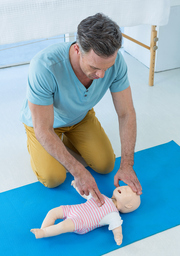Childproofing Beyond the Basics
Childproofing beyond the basics should be a priority for all parents. This is effectively about finding ways to push your core safety measures that little bit further. After all, a few additional preparations and tools can make a significant difference in preventing disasters from arising.
Childproofing isn’t necessarily about investing huge amounts of money in advanced equipment. Neither is it about keeping your children so constrained that they don’t have a positive experience of the world. Rather, it’s about identifying where basic childproofing doesn’t quite do enough and filling the gaps.
Let’s take a closer look at some of the areas you can focus on.
Fire Safety Steps
Fire is a safety concern for a lot of parents. After all, most homes have various fire risks. It isn’t just about the dangers of matches or fireplaces. Electrical items in the home have the potential for fires, too, not to mention some locations experience regular wildfires. There are basic measures you can take, such as teaching children about the hazards and remembering to regularly test smoke alarms. But what else can you do?
Make a fire response plan
In the event of a fire, you need to get yourself and your children to safety. Create a solid plan. This involves drawing a full map of your home and highlighting the most efficient and safe routes out of the home and to a gathering point. Identify alternative routes in case the primary escape area is blocked by fire. Importantly, talk through this plan with your children and even drill them on its use occasionally.
Keep fire extinguishers and blankets
A fire extinguisher can be your most effective response to protect your child if a fire starts in your house. Yet, only around 43% of U.S. households have fire extinguishers. It’s wise to invest in a few fire extinguishers and fire blankets that you can keep in various areas of your home.
Make sure they’re of a weight that you can easily use. As your children get older, show them where the fire extinguishers are kept and how to use them. This empowers them to respond immediately rather than wait for an adult to take care of an emergency.
Remember, too, to regularly assess your home for potential fire hazards. Consider both what can be at risk of fires and what actions your kids might take that cause them. Assess both inside and outside your home. You can then take relevant steps to prevent issues.
Prepare for Medical Emergencies
The basics of childproofing your home will tend to revolve around preventing the potential for medical emergencies to arise in the first place. This is, of course, important, but occasionally accidents and illnesses will happen. A vital next level of childproofing, then, is to prepare yourself and your family to handle medical emergencies when they occur.
Firstly, getting a cardiopulmonary resuscitation (CPR) certification has multiple benefits. Most importantly, it empowers you to save your kids’ lives if they experience cardiac arrest or stop breathing. You could also go on to become an instructor, teaching other members of the community and your children to take care of one another in an emergency.
Taking these courses is particularly important, as performing CPR on children can require different techniques than on adults, and it’s wise to get some guidance. Not to mention that you get to practice the techniques, which builds confidence in your abilities.
It’s also wise to create a comprehensive medical kit. The basics should include a first aid kit with a variety of bandages. However, it’s good to go a little further. Consider your kids’ specific needs. For instance, if they suffer from severe allergies, stocking your kit with EpiPens is sensible.
If possible, get a book on providing first aid so that even your older children can know what to do if you’re not around. You should also put the addresses of nearby medical facilities and doctors’ contact details for different scenarios in the kit, so you’re not scrambling around for these in a medical emergency.
Safeguard Outdoor Areas
When people are childproofing their homes, there’s often a focus on the indoors. This is, after all, where kids are going to be spending the most time and there are lots of potential hazards. However, it’s important to go beyond these basic boundaries and childproof the outdoor spaces, too.
For instance, installing a pool alarm is vital for minimizing the risk of drowning. In the best-case scenario, your child won’t run off on their own, but it can happen. An alarm will trigger when your child either enters the proximity of the pool or when there’s a wave disturbance. You can then quickly respond, avoiding disaster. It’s also important to keep a solid cover over your pool wherever possible, as a further layer of protection against disaster.
If your children spend time playing in your yard, you should also take steps to keep them within the space. This is particularly important if your home is situated next to a busy street. Wherever possible, install fencing around the proximity of your yard, high enough that young children can’t climb over it. You should also put strong latches on any gates, preferably out of reach of young and mischievous hands.
Conclusion
Taking your childproofing beyond the basic steps creates a stronger foundation for your kids’ well-being. This should include investing in solid safety tools and education, among other resources. That said, it’s important to remember that hazards evolve over time. Take the initiative to regularly review your safety measures and make improvements if they’re needed.
About the Author
 Katie Brenneman is a passionate writer specializing in education, mental health, family lifestyle and online safety. When she isn’t writing, you can find her with her nose buried in a book or hiking with her dog, Charlie. You can follow her on Twitter.
Katie Brenneman is a passionate writer specializing in education, mental health, family lifestyle and online safety. When she isn’t writing, you can find her with her nose buried in a book or hiking with her dog, Charlie. You can follow her on Twitter.





